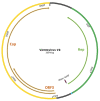Redondoviridae: High Prevalence and Possibly Chronic Shedding in Human Respiratory Tract, But No Zoonotic Transmission
- PMID: 33804837
- PMCID: PMC8063800
- DOI: 10.3390/v13040533
Redondoviridae: High Prevalence and Possibly Chronic Shedding in Human Respiratory Tract, But No Zoonotic Transmission
Abstract
Redondoviridae is a recently discovered DNA virus family consisting of two species, vientovirus and brisavirus. Here we used PCR amplification and sequencing to characterize redondoviruses in nasal/throat swabs collected longitudinally from a cohort of 58 individuals working with animals in Vietnam. We additionally analyzed samples from animals to which redondovirus DNA-positive participants were exposed. Redondoviruses were detected in approximately 60% of study participants, including 33% (30/91) of samples collected during episodes of acute respiratory disease and in 50% (29/58) of baseline samples (with no respiratory symptoms). Vientovirus (73%; 24/33) was detected more frequently in samples than brisaviruses (27%; 9/33). In the 23 participants with at least 2 redondovirus-positive samples among their longitudinal samples, 10 (43.5%) had identical redondovirus replication-gene sequences detected (sampling duration: 35-132 days). We found no identical redondovirus replication genes in samples from different participants, and no redondoviruses were detected in 53 pooled nasal/throat swabs collected from domestic animals. Phylogenetic analysis described no large-scale geographical clustering between viruses from Vietnam, the US, Spain, and China, indicating that redondoviruses are highly genetically diverse and have a wide geographical distribution. Collectively, our study provides novel insights into the Redondoviridae family in humans, describing a high prevalence, potentially associated with chronic shedding in the respiratory tract with lack of evidence of zoonotic transmission from close animal contacts. The tropism and potential pathogenicity of this viral family remain to be determined.
Keywords: animals; brisavirus; persistence; redondoviruses; respiratory; vientovirus; zoonosis.
Conflict of interest statement
The authors declare no conflict of interest.
Figures


References
-
- WHO . Research Needs for the Battle Against Respiratory Viruses (BRaVe) WHO; Geneva, Switzerland: 2013. pp. 1–35.
-
- European Respiratory Society . The Global Impact of Respiratory Disease. 2nd ed. European Respiratory Society; Lausanne, Switzerland: 2017.
-
- World Health Organisation Coronavirus Disease (COVID-19) Situational Report 51. [(accessed on 12 March 2020)];2019 Available online: https://www.who.int/docs/default-source/coronaviruse/situation-reports/2....
-
- Vong S., Guillard B., Borand L., Rammaert B., Goyet S., Te V., Try P.L., Hem S., Rith S., Ly S., et al. Acute lower respiratory infections in ≥5 year -old hospitalized patients in Cambodia, a low-income tropical country: Clinical characteristics and pathogenic etiology. BMC Infect. Dis. 2013;13:97. doi: 10.1186/1471-2334-13-97. - DOI - PMC - PubMed
Publication types
MeSH terms
Grants and funding
LinkOut - more resources
Full Text Sources
Other Literature Sources

